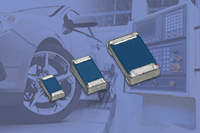source: Vishay news
MALVERN, Pa. — November 13, 2017 — Vishay Intertechnology, Inc. (NYSE: VSH) today introduced a new series of Automotive Grade thin film chip resistors that features the industry’s highest rated power dissipation in the compact 0402, 0603, and 0805 case sizes. For electronics in automotive, industrial, and renewable energy applications, Vishay Beyschlag MC HP series devices combine high operating temperatures to +175 °C with low load life drift ≤ 0.2 % after 1,000 hours of operation at rated dissipation.
With rated power dissipation up to 0.4 W, the MCS 0402 HP, MCT 0603 HP, and MCU 0805 HP each deliver over two times the dissipation of standard thin film chip resistors in their respective case size, while also exceeding the ratings of components in the next largest case size. To save space, reduce component counts, and lower costs, this allows designers to use compact resistors in place of larger devices, or replace multiple resistors of the same case size.
The AEC-Q200 qualified devices released today feature a resistance range from 1 Ω to 100 kΩ, TCR down to ± 25 ppm/K, and tolerances down to ± 0.1 %. The MC HP series offers superior temperature cycling robustness and advanced sulfur resistance as verified according to ASTM B 809. Suitable for processing on automatic SMD assembly systems, the lead (Pb)-free devices are RoHS-compliant.
The MCS 0402 HP, MCT 0603 HP, and MCU 0805 HP are the perfect choice for most fields of modern electronics in which power dissipation, reliability, stability, and robust design are major concerns. Typical applications will include DC/DC converters; power supply, motor, and electronic control units; inverters; and test and measuring equipment.
Device Specification Table:
| Part number | MCS 0402 HP | MCT 0603 HP | MCU 0805 HP | |||||
|---|---|---|---|---|---|---|---|---|
| Case size | 0402 | 0603 | 0805 | |||||
| Resistance range (Ω) | 47 to 100 k | 1 to 100 k | 1 to 100 k | |||||
| Resistance tolerance (%) | ± 0.1; ± 0.5 ± 1 | |||||||
| TCR (ppm/K) | ± 25; ± 50 | |||||||
| Rated dissipation P85 (W) | 0.200 | 0.250 | 0.400 | |||||
| Operating voltage (V) | 50 | 75 | 150 | |||||
| Operating temp. range (°C) | -55 to +175 | |||||||
Samples and production quantities of the new thin film chip resistors are available now, with lead times of six to eight weeks for large orders.































